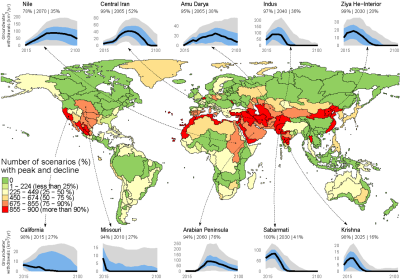Groundwater Use May Peak Globally Over the 21st Century
Nearly all (98%) of the Earth’s liquid freshwater exists in vast stores of nonrenewable sub-surface groundwater. For the past half century, humans have extracted this resource at steep rates for agricultural production and trade. While vast stores of groundwater still exist in many regions, the reserves will become more costly to extract as groundwater tables fall. This has implications for the cost of growing crops, affecting food production and trade. There remains uncertainty surrounding groundwater’s future role in meeting water demands across the world’s large river basins. Our integrated modeling of the global human-Earth system finds that rather than increasing indefinitely, extraction is likely to peak around the mid-21st century and then be followed by a steady decline. The peak and decline occur in about one-third of global river basins in our results, including 21 basins that may have already peaked, exposing about half (44%) of the global population to groundwater stress. This pattern is similar to that observed for most depletable natural resources, such as fuels and minerals, suggesting that, despite its abundance, a major transformation may be needed to more conservatively value and manage groundwater.
Water, in all its forms, is often perceived as a renewable resource that will replenish itself in perpetuity, and humanity’s management of water has reflected this perception (e.g., via unsustainable groundwater extraction). Previous research put forth the “peak water limits” hypothesis, which argues that future groundwater extraction will peak and decline, as has been observed for other depletable resources, such as minerals and fuels. Our study provides the first comprehensive quantitative analysis of this hypothesis at the global scale by quantifying the timing and magnitude of global groundwater peak and decline across all global river basins under a diverse range of future human and Earth system uncertainties.
Our findings also expose previously unquantified risks, including the potential for rising groundwater and food costs and shifting patterns of global agricultural trade. Quantification of the specific timing and magnitude across basins globally improves our understanding of groundwater’s time-evolving role in supplying future water demands, and it illuminates the costs and benefits of more conservative groundwater management strategies in regions that might be exposed to peak-and-decline-induced groundwater stress. More broadly, these findings demonstrate how the presence of a future peak and decline may result in a redistribution of global water extraction, food production, and trade in the coming decades, along with substantial infrastructure investment needs.
Nonrenewable (i.e., fossil) groundwater extraction has fueled global agricultural production and international trade over the past half century, yet there is limited knowledge of how this extraction might evolve over the remainder of the 21st century. We use GCAM, an integrated model of the coupled human-Earth system with well-established representations of the dynamic interactions between socioeconomic, energy, land, water, and climate systems, to simulate groundwater withdrawals over the 21st century across 235 water basins under 900 scenarios. Our approach to integrated human and Earth system change extends far beyond the traditional modeling of the physical hydrosphere that has characterized most global analyses of groundwater.
We find that rather than increasing indefinitely, groundwater extraction is likely to peak around the mid-21st century, followed by a steady decline. This pattern emerges, in large part, because deeper groundwater reserves will become increasingly costly to exploit, and because the human system has various options to respond to increasing groundwater costs (e.g., by shifting agricultural production and trade patterns). Our analysis goes beyond typical water studies by considering broader system changes. Despite the diversity of modeled scenarios explored, we still find that the distinct peak-and-decline signature is present in 98% of scenarios. This pattern is analogous to that observed for most depletable natural resources, such as minerals, underscoring that despite its abundance, groundwater is ultimately a depletable, rather than an inexhaustible, resource. The presence and timing of peak and decline in these regions will carry consequences for the future geography of international agricultural trade.

